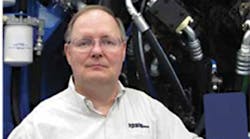I’m always pleased to hear how many seasoned veterans in the fluid power industry cite Hydraulics & Pneumatics as a recurring source of information they’ve relied on through the years, and still do. It’s probably the biggest reason why I’m proud to carry on the legacy begun and nurtured by my predecessors nearly 70 years ago. On the other hand, as skilled craftsmen retire from the industry, and companies downsize, those new to the industry have less access to the wisdom and experience of these experts who were essential to advancing fluid power technology and applications into what they are today.
This file type includes high resolution graphics and schematics when applicable.
That’s where I think H&P has become even more valuable than ever—by sharing the knowledge and wisdom of experts on our printed and Web pages. Most companies had engineers, designers, technicians, and mechanics with years of experience to share with colleagues who were new to the technology. But downsizing has caused retirees not to be replaced, and those left in the wake of this attrition lose a valuable resource for helping them solve problems.
This all came to me after I received a call from Bob Archer several weeks ago. Bob called to see if I’d be interested in publishing an article he wrote describing the phenomenon of blowdown in relief valves. Bob is retired after working for decades in various technical fields, and his P.E. license assured me that he knows his stuff. Bob’s article is interesting and informative, and where else but in H&P would you find a four-page article on relief valves?
A similar situation occurred about two years ago, when I was contacted by Pete Stroempl. He said he was retiring, and had wanted to investigate some questions he had about hose design. He didn’t have enough time to work on these while working full time, but now that he was retired, he could pursue his passion. The result is a pair of articles we published last year and in 2012. After he conquered his quests, Pete said he got bored with retirement and took on another job.
The one big advantage I have over any other editor in this field is an archive of great material going back to 1948, when H&P was first published as Applied Hydraulics magazine. Granted, the further back I go, the less likely I’ll find material that is relevant today. But if the original article deals with fundamental principles that never change, it will still be relevant. For example, I found a comprehensive two-part article from the late 1960s on how air gets into hydraulic fluid. Another, which I’m still looking for, is a definitive treatise on bulk modulus of hydraulic fluid.
So if you don’t have seasoned experts to help you hone your fluid power knowledge, try browsing through our archives. Click on Site Archive at the bottom-left of our home page (and most others), and you’ll see a chronological list of issues we’ve archived from as far back as 1967.
This file type includes high resolution graphics and schematics when applicable.


